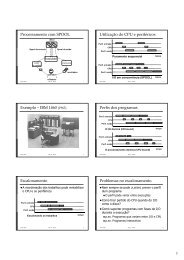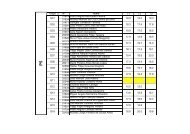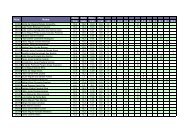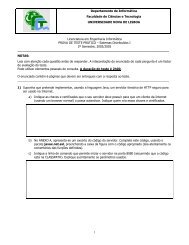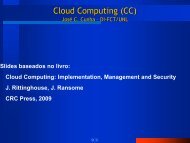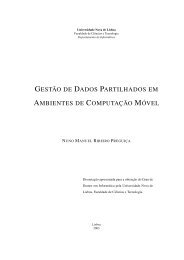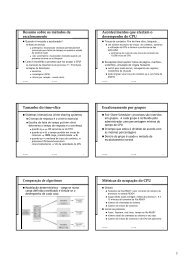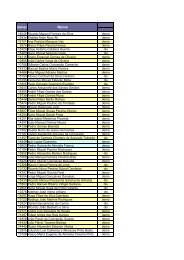Dissertaç ˜ao de Mestrado Mestrado em Engenharia Informática Jo ...
Dissertaç ˜ao de Mestrado Mestrado em Engenharia Informática Jo ...
Dissertaç ˜ao de Mestrado Mestrado em Engenharia Informática Jo ...
You also want an ePaper? Increase the reach of your titles
YUMPU automatically turns print PDFs into web optimized ePapers that Google loves.
6. INTEGRATION WITH VIRTU 6.5. Summary<br />
grammars with the corresponding parsers and discards the rest. Besi<strong>de</strong>s that, the Tentative<br />
Grammar Repository will now interact with the Eclipse Views and the Web Front-<br />
Ends.<br />
SmART User Interface<br />
The User Interface will be integrated in the Presentation Layer with the Eclipse<br />
Views Front-End and the Web Front-End, so as to provi<strong>de</strong> a way for the administrator<br />
to perform the tasks of creating the Publication Files, when new Building Blocks<br />
are ad<strong>de</strong>d to VIRTU, and building new grammars when parsers capable of recognizing the<br />
configuration files of the Building Blocks do not exist in the database.<br />
6.4.2 SmART Generic to Original syntax Converter<br />
As for Printer and PrinterMain, they will form an autonomous process in the boot sector<br />
of each virtual machine, which transforms a Publication File on a configuration file, if<br />
that Publication File modification flag is set.<br />
6.4.3 Parser Generator<br />
Much like in SmART, the Parser Generator component will be consi<strong>de</strong>red as third-party<br />
software, therefore, this component will resi<strong>de</strong> as an external package in the third-party soft-<br />
ware repository. It is accessed solely by the Grammar Compiler.<br />
6.5 Summary<br />
At the time of elaboration of this dissertation, the integration of SmART with VIRTU was only<br />
commencing. This chapter presents the result of project meetings where we analysed ways in<br />
which both tools can be merged, from the point of view of the VIRTU tool. The taken approxi-<br />
mation consists on joining the SmART components with the existing VIRTU ones.<br />
By merging the prototype of a framework on a bigger tool whose <strong>de</strong>velopment is well un-<br />
<strong>de</strong>r way, the adaptation of some prototype components should be expected. This is the case of<br />
the SmART Parser Repository, which will be tranformed from a simple list of parsers into<br />
a set of relations in the VIRTU Configuration Database. This adaptation is not straight-<br />
forward though, as with most of the available parser generators, the produced parsers will<br />
consist on a set of Java classes. The classes that compose the parser can be stored in the data-<br />
base without any hassle, nevertheless, they cannot be executed from there. Three alternatives<br />
for the execution of the parser classes were i<strong>de</strong>ntified: to copy the classes locally to a t<strong>em</strong>porary<br />
fol<strong>de</strong>r and execute th<strong>em</strong>; to copy the classes to m<strong>em</strong>ory and run th<strong>em</strong> from there; to execute<br />
a database method which allows the parser classes to be ran from the database. After the<br />
project meeting, another solution for this probl<strong>em</strong> was i<strong>de</strong>ntified, which consists on gathering<br />
the parser classes in a .JAR container [Mic09d] and storing the packages in the database. In this<br />
77



